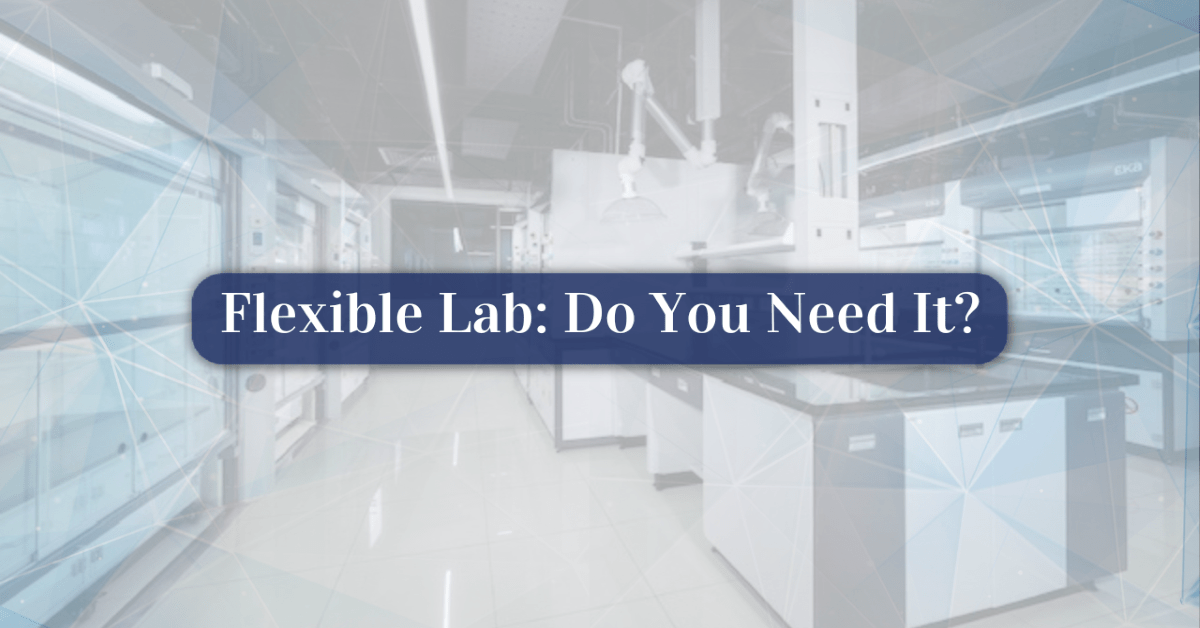As Lab spaces are changing continuously to keep pace with changing requirements and times, the term ‘Flexible Lab Design’ is often heard. It would be prudent therefore to get conversant with this concept. Any new concept catches attention and merits discussions. However, each lab is different in terms of its nature, objectives, and outcomes. How far and well-suited is this concept for your specific lab, must be carefully evaluated.
What is a Flexible Lab?
Advantages of Flexible Labs
The following advantages are offered:
- Quick configuration changes & very less downtime.
- Very minimal costs for infrastructure changes.
- Built-in scope for future expansion
- Multiple plug-and-play points for utility tapping for mobile equipment.
- Accommodates interdisciplinary research using the same infrastructure.
- Smoother interaction between ‘wet’ and ‘dry’ spaces.
- Efficient and safer storage. Overall improved ergonomics.
- Promotes an open and collaborative work culture and always keeps scientists comfortable.
Limitations of Flexible Labs
The concept does have some limitations:-
- Much higher investment in design, materials, and equipment.
- Increased complexity in engineering.
- Risk of introducing extra flexibility and overdesign.
Flexibility could mean different to different scientists. While this could liberate most of them from the botheration of downtime and costs of infrastructure changes, it could be perceived by some as challenging to their professional freedom and privacy.
Whether to go Flexi or Not?
This crucial design must involve all stakeholders and mustn’t be limited to architects and engineering teams. To begin with, your lab’s objectives, processes, and workflows must be clearly defined. Does the workflow demand flexibility? To what extent? Are you setting up a Research lab or a QA lab? What kind of research changes do you expect in the future? What kind of real changes do you foresee in the short, medium, and long time in the life of your lab? Does the lab warrant a much higher investment for perceived flexibility? Would the engineering and maintenance resources suffice? Are your scientists enthused with the concept? Their participation is an absolute must at this stage.
The decision-making should be based on objectives and hard facts. True that the concept of flexible lab design looks far too attractive but whether you need to invest your time and resources is a relative and difficult decision. You may involve external agencies such as Architects, Planners, and Lab Furniture manufacturers to get yourself updated with information. Finally, your stakeholder’s team must decide at the end of a meaningful debate.
Is it Possible to Strike a Balance?
Yes indeed. Instead of introducing and then having to live with unnecessary and underused flexibility, you can always strike a balance. Your team may consider introducing necessary but limited flexibility. Labguard offers furniture that can help reconfigure the layout from an ‘Island configuration’ to a ‘Wall-side configuration’. Also, the standing-height tables could be converted to sitting-height ones. Some furniture could be ordered on the castors. Flexible shelving is also available for storage.
Fume hoods pose challenges as they are bulky and connected to rigid ductwork. Labguard has a collaboration with Erlab- France, and offers very efficient ductless fume hoods that are portable and safe. Even higher widths from 6 feet and 8 feet are available now. These hoods can be hand ported or mounted on castors and do not need rigid ductwork, being recirculating type hoods. These hoods add immense flexibility. Many experiments can be safely moved to ductless fume hoods. They are a smart choice when there is a demand for flexibility.
A modern approach to the utility layout along with the availability of modern snap-on/ snap-off (Quickconnect Broen make or similar) type utility fittings for valves and taps can help scientists move experiments and equipment easily. Together these modern choices make your lab flexible to a great extent. Many objectives of a flexible lab design could be achieved with smart out-of-the-box thinking. It is possible to provide for some future adjustments, instrumentation, and IT networking with a conventional approach at a much-reduced cost.
Practical flexibility, an eye on Capex, lower maintenance costs, higher energy efficiency, and sustainability could be achieved without going for an unconventional flexible lab design. Remember, it is not possible to future-proof a lab in the modern world. Hence management by objectives must guide decision-making.
Whether flexible, conventional or balanced lab design, we at Labguard are equipped with modern technologies and products to help you with your project. Do get in touch with us.


